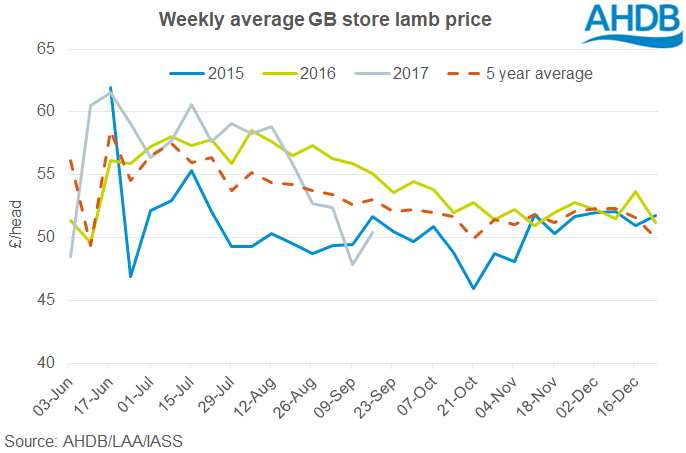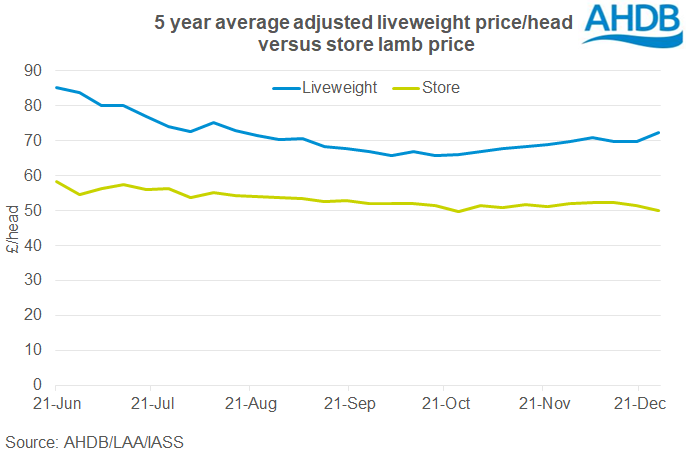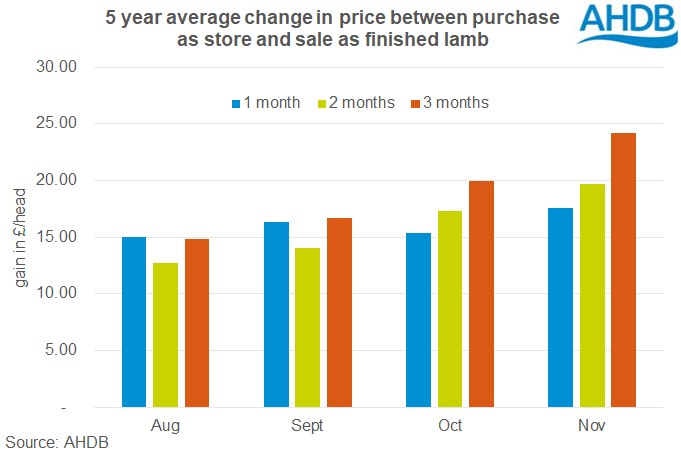How much value does a store lamb gain?
Thursday, 5 October 2017
By Annie Linekar
The number of lambs sold as stores has increased in recent years. In 2016, over 1.8 million lambs were sold as stores through GB auction markets, which does not include lambs sold privately.
Although producers made money on average according to the AHDB 2016 Stocktake Report, the bottom third of producers didn’t achieve even a positive cash-only net margin. In 2015, industry reports suggest that a number of farmers lost money on the finishing of store lambs. This begs the question as to how profitable is finishing store lambs.

Store lamb prices have remained below 2016 levels since week ended 16 August. In August 2017, average store lamb prices were at £56.42 /head, down by around £1 (2%) on 2016 figures. Nonetheless, this is still almost £7 above 2015 levels in the same month, which was the lowest August store price since 2009.
Anecdotal industry accounts suggest that low prices may be partially attributed to the level of finishing the stores require. Although a rise in prices in September may indicate an end to this trend, prices remain significantly lower than 2016, which may put pressure on the ability to achieve high profits from the purchase and finishing of stores. Profits of course are not determined by selling prices alone, cost management plays an equal role.

To compare the prices of stores and finished lambs, 5 year average liveweight SQQ prices have been adjusted using the average finished lamb weight of 42.3kg to produce an average price per head. Lighter average finished weights in August and September have also been accounted for.
Store lamb prices follow similar trends to finished lamb prices. However, a store lamb would rarely be sold immediately post purchase. When comparing store lamb prices with finished prices one, two, and three months apart, the correlation weakens. Hence, buying a store lamb when prices are high does not necessarily mean a high sale price will be gained.
The price gain per head is highest when lambs are kept for 3 months. Purchasing lambs later in the year, when prices tend to have fallen away, and selling early in the New Year has overall been shown to add the most value. To make the most of seasonal high prices, it may appears most beneficial to sell in the first month when buying stores in August or September. However the feasibility of this is low, considering that cheaper lambs will likely be lighter and need more finishing; on average around 95 days.

The added variable costs of finishing lambs are not incorporated into this chart. The variable costs will vary depending on the efficiency of the producer’s system, and average between £7.04 to £11.08, plus an added 2% of final finished price to account for lamb mortality within the flock. Furthermore, while the greatest margins are achieved over the winter months, the increased cost of keep in this period may counter potential gains.
Growing lambs generally eat around 4% of their bodyweight as dry matter per day. The extra pressure that this puts on pastures should not be discounted, alongside the value of such grazing for other livestock. Another cost that needs accounting for is the field may need fertilising. Fixed costs such as labour and rent should also be included to assess whether finishing lambs is the best use of land available, as assessed in the AHDB Growing and finishing lambs for Better Returns document. Costs are further increased by diseases and lamb mortality, hence, minimising losses and variable costs is vital.
In recent weeks the liveweight lamb price has been dropping, but does remain slightly above 5 year average figures. In conjunction with the fall in store lamb price, this may indicate the potential for positive margins to be made from store lamb finishing this year. However, the ability to react to price changes and control costs remain key in achieving a profit.
Sign up for regular updates
You can subscribe to receive Beef and Lamb market news straight to your inbox. Simply fill in your contact details on our online form.
While AHDB seeks to ensure that the information contained on this webpage is accurate at the time of publication, no warranty is given in respect of the information and data provided. You are responsible for how you use the information. To the maximum extent permitted by law, AHDB accepts no liability for loss, damage or injury howsoever caused or suffered (including that caused by negligence) directly or indirectly in relation to the information or data provided in this publication.
All intellectual property rights in the information and data on this webpage belong to or are licensed by AHDB. You are authorised to use such information for your internal business purposes only and you must not provide this information to any other third parties, including further publication of the information, or for commercial gain in any way whatsoever without the prior written permission of AHDB for each third party disclosure, publication or commercial arrangement. For more information, please see our Terms of Use and Privacy Notice or contact the Director of Corporate Affairs at info@ahdb.org.uk © Agriculture and Horticulture Development Board. All rights reserved.

